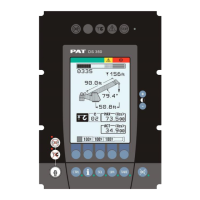Service Manual iFLEX5
© Hirschmann Rev. I 0522/17 190154_I.DOC
3 DESCRIPTION OF THE SYSTEM
3.1 DESCRIPTION OF SYSTEM FUNCTION
The iFLEX5 system is a CAN bus system made up of a central microprocessor unit, operating
console, length/angle sensor, pressure transducers, and anti-two block switches. All components and
sensors are equipped with CAN bus controllers.
The PAT Load Moment Indicator system operates on the principle of reference/real comparison. The
real value, resulting from the pressure measurement is compared with the reference data, stored in
the central processor memory and evaluated in the microprocessor. When limits are reached, an
overload warning signal is generated at the operator’s console. At the same time, the aggravating
crane movements, such as hoist up, telescope out and boom down, will be stopped.
The fixed data regarding the crane, such as capacity charts, boom weights, centers of gravity and
dimensions are stored in memory chips in the central processor unit. This data is the reference
information used to calculate the operating conditions.
Boom length and boom angle are registered by the length/angle sensor, mounted inside the cable
reel, which is mounted on the boom. The boom length is measured by the cable reel cable, which also
serves as an electrical conductor for the anti two-block switches.
The crane load is measured by pressure transducer block attached to the piston and rod side of the
hoist cylinders.
The interactive user guidance considerably simplifies the input of operating modes as well as the
setting of geometry limit values.
3.2 DESCRIPTION OF A CAN BUS SYSTEM
CAN stands for “Controller Area Network”. Its intended use is as a serial bus system for a network of
controllers. Each controller connected through a CAN chip is called a "node" and is mostly used to
acquire data from a sensor. All nodes are connected to a common bus and all nodes are able to
simultaneously read the data on that bus. Also, all nodes are able to transmit data on that bus
however only one node at a given time has write access to the bus. If the message is relevant, it will
be processed; otherwise it is ignored. The unique identifier also determines the priority of the
message. The lower the numerical value of the identifier, the higher the priority.
The cable bus is a twisted pair of shielded wire. Data can be transmitted in blocks from 0-8
bytes at a maximum transfer rate of 1 Mbit/s for networks up to 40 meters. For longer network
distances the maximum transfer rate must be reduced to 50 Kbit/s for a 1 km network distance.
CAN will operate in extremely harsh environments and the extensive error checking
mechanisms ensure that any transmission errors are detected.

